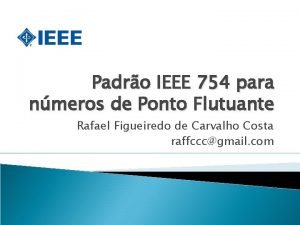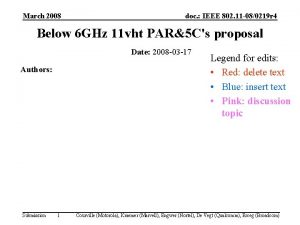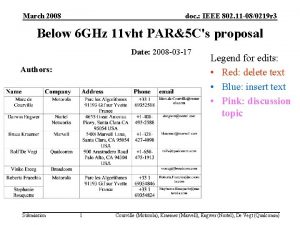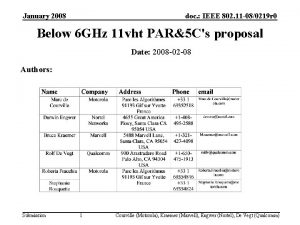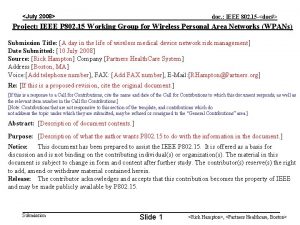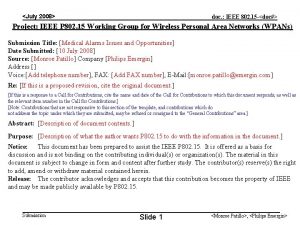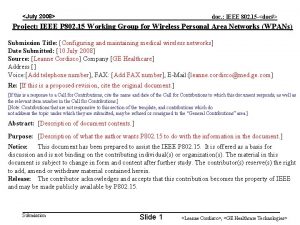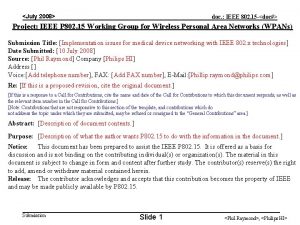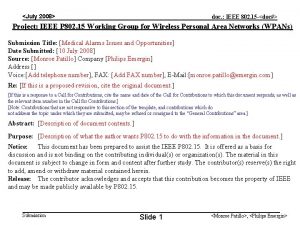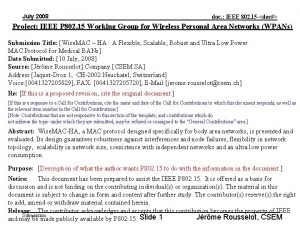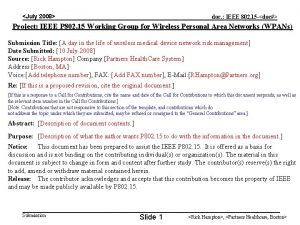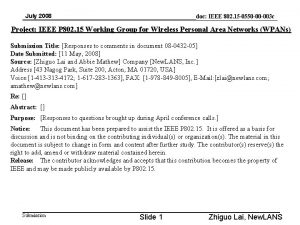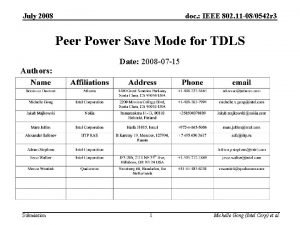July 2008 doc IEEE 802 22 080219 r














![July 2008 doc. : IEEE 802. 22 -08/0219 r 0 References [1] Submission IEEE July 2008 doc. : IEEE 802. 22 -08/0219 r 0 References [1] Submission IEEE](https://slidetodoc.com/presentation_image_h2/9bcdaa61245da9ae5457849e6e761461/image-15.jpg)
- Slides: 15

July 2008 doc. : IEEE 802. 22 -08/0219 r 0 TG 1 Required Detection SNRs Versus Protected Radii IEEE P 802. 22 Wireless RANs Date: 2008 -07 -17 Authors: Notice: This document has been prepared to assist IEEE 802. 22. It is offered as a basis for discussion and is not binding on the contributing individual(s) or organization(s). The material in this document is subject to change in form and content after further study. The contributor(s) reserve(s) the right to add, amend or withdraw material contained herein. Release: The contributor grants a free, irrevocable license to the IEEE to incorporate material contained in this contribution, and any modifications thereof, in the creation of an IEEE Standards publication; to copyright in the IEEE’s name any IEEE Standards publication even though it may include portions of this contribution; and at the IEEE’s sole discretion to permit others to reproduce in whole or in part the resulting IEEE Standards publication. The contributor also acknowledges and accepts that this contribution may be made public by IEEE 802. 22. Patent Policy and Procedures: The contributor is familiar with the IEEE 802 Patent Policy and Procedures http: //standards. ieee. org/guides/bylaws/sb-bylaws. pdf including the statement "IEEE standards may include the known use of patent(s), including patent applications, provided the IEEE receives assurance from the patent holder or applicant with respect to patents essential for compliance with both mandatory and optional portions of the standard. " Early disclosure to the Working Group of patent information that might be relevant to the standard is essential to reduce the possibility for delays in the development process and increase the likelihood that the draft publication will be approved for publication. Please notify the Chair Carl R. Stevenson as early as possible, in written or electronic form, if patented technology (or technology under patent application) might be incorporated into a draft standard being developed within the IEEE 802. 22 Working Group. If you have questions, contact the IEEE Patent Committee Administrator at patcom@iee. org. > Submission 1 Stephen Kuffner, Motorola

July 2008 doc. : IEEE 802. 22 -08/0219 r 0 Abstract To protect microphone receivers over the full TG 1 keepout zone, the WRANs need to detect beacons at lower SNRs depending on the keepout zone radius. This submission determines the required detection SNR versus the protected radius. Submission 2 Stephen Kuffner, Motorola

July 2008 doc. : IEEE 802. 22 -08/0219 r 0 Interference Scenario NEWS 7 reporter WRAN news gathering truck w/ beacon Rp Rd Submission camera operator 3 Stephen Kuffner, Motorola

July 2008 doc. : IEEE 802. 22 -08/0219 r 0 Interference Scenario: Another View interference region interference range Ri microphone protected region WRAN θ interference angle Rd Rp detection range Beacon protected radius • For a beacon using a protected radius Rp, the microphone receivers can be that much closer to the WRAN than the beacon • Note all aggregated microphone receivers must be within the protected radius Submission 4 Stephen Kuffner, Motorola

July 2008 doc. : IEEE 802. 22 -08/0219 r 0 Set Up • Path loss model is simple two ray with h 2 dependence • In the 4 th law region, • This path loss model can be applied to both the interference path and the detection path • Both paths can be solved for Rd , equated, and solved for the required S/N Submission 5 Stephen Kuffner, Motorola

July 2008 doc. : IEEE 802. 22 -08/0219 r 0 Link Equations • Beacon-to-WRAN detection path Solve for Rd • WRAN Tx-to-microphone interference path Note Rd – Rp is the desired max interference range Ri Submission 6 Stephen Kuffner, Motorola

July 2008 doc. : IEEE 802. 22 -08/0219 r 0 Link Parameters Parameter Sb , Sw Meaning Parameter Beacon, WRAN Tx power spectral density F↑, F↓ Meaning Interference up-fade, beacon down-fade Bb , Bw Beacon chip BW, WRAN BW Antenna, interference, and receiver noise temperatures for microphone receiver hb, hw, hm Beacon, WRAN, and microphone Rx antenna heights Antenna, interference, and receiver noise temperatures for WRAN receiver Submission Beacon, WRAN Tx antenna gain I/N Interference-to-noise ratio at microphone receiver WRAN, microphone Rx antenna gain S/N Beacon signal SNR at WRAN receiver 7 Stephen Kuffner, Motorola

July 2008 doc. : IEEE 802. 22 -08/0219 r 0 Combined Link Equation • Combining the two path equations for Rd, solve for the required S/N • Note the down fade F↓ has been absorbed into a faded S/N since faded S/N values are what we have from the PER simulations Submission 8 Stephen Kuffner, Motorola

July 2008 doc. : IEEE 802. 22 -08/0219 r 0 Computation Assumptions • • • Beacon VHF transmit power = 50 m. W Beacon UHF transmit power = 250 m. W Beacon antenna radiating centers = 3. 5 m or 9. 5 m WRAN antenna height = 9 m Beacon Tx antenna gain = 2 d. Bi Microphone Rx antenna gain = 0 d. Bi WRAN Tx antenna gain = 6 d. Bi VHF, 8 d. Bi UHF WRAN Rx antenna gain (sensing) = 0 d. Bi Receiver Noise Temps = 1200 K, Antenna Temps = 300 K, Interference Temps = 0 K • WRAN EIRP = 36 d. Bm, WRAN BW = 5. 625 MHz • Protected Radii = 0, 500 m, 1500 m, and 4500 m • I/N = 0 d. B Submission 9 Stephen Kuffner, Motorola

July 2008 doc. : IEEE 802. 22 -08/0219 r 0 VHF Results Submission 10 Stephen Kuffner, Motorola

July 2008 doc. : IEEE 802. 22 -08/0219 r 0 UHF Results Submission 11 Stephen Kuffner, Motorola

July 2008 Submission doc. : IEEE 802. 22 -08/0219 r 0 12 Stephen Kuffner, Motorola

July 2008 doc. : IEEE 802. 22 -08/0219 r 0 WRAN-B Faded Channel Profile [1] Ray 1 Ray 2 Ray 3 Ray 4 Ray 5 Ray 6 Mag (d. B) -6 0 -7 -22 -16 -20 Delay (μsec) -3 0 2 4 7 11 • This channel model is typically used as the worst-case channel model in IEEE 802. 22 analyses Submission 13 Stephen Kuffner, Motorola

July 2008 doc. : IEEE 802. 22 -08/0219 r 0 Conclusions • For large protected radii, the required SNR and detection probability can be increased by using a higher beacon antenna Submission 14 Stephen Kuffner, Motorola
![July 2008 doc IEEE 802 22 080219 r 0 References 1 Submission IEEE July 2008 doc. : IEEE 802. 22 -08/0219 r 0 References [1] Submission IEEE](https://slidetodoc.com/presentation_image_h2/9bcdaa61245da9ae5457849e6e761461/image-15.jpg)
July 2008 doc. : IEEE 802. 22 -08/0219 r 0 References [1] Submission IEEE 802. 22 -05/0055 r 7, “WRAN Channel Modeling, ” E. Sofer, G. Chouinard, Sept. 2005 15 Stephen Kuffner, Motorola













